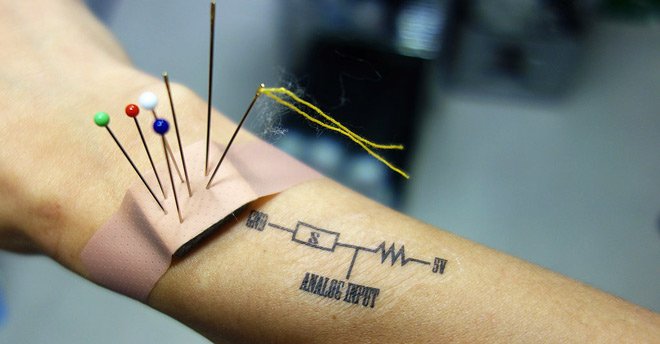
Telangana. 27th Jul 2020
“Through a vastly reduced tattoo thickness and increased stretchability, a ‘SkinMark’ is sufficiently thin and flexible to conform to irregular geometry, like flexure lines and protruding bones.”
“Through a vastly reduced tattoo thickness and increased stretchability, a ‘SkinMark’ is sufficiently thin and flexible to conform to irregular geometry, like flexure lines and protruding bones.”
New Delhi: Google is working on smart tattoos that, when applied to skin, will transform the human body into a living touchpad via embedded sensors.
Part of Google Research, the wearable project is called “SkinMarks” that uses rub-on tattoos.
The project is an effort to create the next generation of wearable technology devices, the CNET reported citing white papers and demo videos.
Here’s how the technology works.
The sensor-driven tattoos are applied to a part of the body.
The sensors can then be triggered by traditional touch or swipe gestures, like we perform on smartphones.
There are a few gestures that are more specific to working on the skin’s surface.
“You could squeeze the area around the tattoo or bend your fingers or limbs to activate the sensors”.
The researchers at Saarland University in Germany wrote in a white paper that the benefit of using skin as an interface “is tapping into the fine motor skills that human beings naturally have”.
The project is partly funded through Google Faculty Research Awards.
Part of Google Research, the wearable project is called “SkinMarks” that uses rub-on tattoos.
The project is an effort to create the next generation of wearable technology devices, the CNET reported citing white papers and demo videos.
Here’s how the technology works.
The sensor-driven tattoos are applied to a part of the body.
The sensors can then be triggered by traditional touch or swipe gestures, like we perform on smartphones.
There are a few gestures that are more specific to working on the skin’s surface.
“You could squeeze the area around the tattoo or bend your fingers or limbs to activate the sensors”.
The researchers at Saarland University in Germany wrote in a white paper that the benefit of using skin as an interface “is tapping into the fine motor skills that human beings naturally have”.
The project is partly funded through Google Faculty Research Awards.
No comments:
Post a Comment